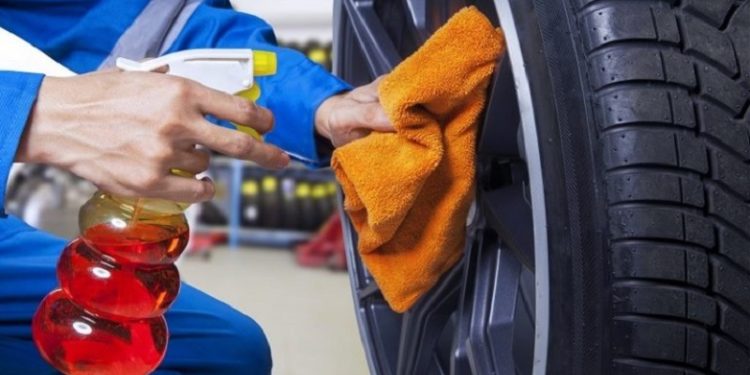What is a tyre valve?
A tyre valve is a very important part of every tyre which helps to keep the tyre sealed and maintain air pressure inside. A tyre valve is made up of three parts; the body, the core and the cap to cover it.
A valve must always have it’s cap on or it needs to be changed probably.
Different types of valve stems:
Valve stems are different according to the needs and requirement of your vehicle, So you should make sure, you’ve put on the right one. These include;
1. Rubber Valve Stems
These are made for standard use for motorcycles and trailers and are main of high quality rubber.
2. Snap-in Valve Stems:
These are great for low pressure tyres and are easy to install as well.
3. Metal Valve Stems
These are for high performance tyres and provide better quality to maintain the temperatures and pressure.
4. Bolt In Valve Stems
These are for heavy duty and off-road vehicles and are much more durabe than the snap on valves.
Why is my tyre losing air pressure?
If your tyre is losing 3 – 4 psi a month then it’s completely normal as it’s the ideal rate of decreasing, but however if you feel a much faster rate of decreasing Psi levels than surely, you will find signs of slow leakage in your tyre, probably faulty car tyre valve.
It is very important that you check on it as soon as possible, as sometimes such small mistakes cause some greater accidents.
It is very important to check on your tyres once a month as the longer you wait the more the Psi levels will decrease.
Signs of faulty Car Tyre Valve:
Some of the other signs of a faulty car tyre valve includes:
- Visual and audible air leakage effects and signs
- Corrosion of the valve stem
- Signs of difficulty inflating the tyre
When should the tyre valve be replaced?
1 – When changing a tyre
When changing the tyres it is better if the tyre valve is also replaced, If it is simple tyre valve than it is cut off and replaced with a new one, However if it is a TPMS (Tyre Pressure Monitoring System), Then only the seal is replaced to help maintain the air pressure
2 – When the tyre valve is porous
Sometimes, if you detect the slow pressure loss, it might be because of the porosity in the valve. Porosity in the tyre valve can emerge because of long term use of the same tyre valve, as the rubber material in the seal wears it starts compromising the air pressure and eventually causes issues.
Cost of Replacing a Tyre Valve
The estimated cost varies according to the type of valve stem you require, If
- Rubber Snap-In for Valve Stem for Tubeless Tyres (Standard One) : 3£
- Rubber Snap-In for Valve Stem for Tubeless Tyres (High Pressure) : 9£
- Metal Valve Stem : 7£ / Pack
- Valve Cap : 5£ / Pack
Note : These are only expected prices, if you want a real estimate contact any Professional tyre valve replacement shop.
How do I find a slow leak on a Tyre?
1. Listen for the Hissing Sound
First way is to identify the hissing sound of the escaping air pressure, however if you find it difficult Then,
2. Use Soap Water Trick
Mix dish soap and water to form a liquid, which you can spray on tyre valve or tyre tread or sidewalls to find the defected place. If bubbles appear it means the air is leaking and if not then possibly the defect is in any other area.
How you can solve tyre valve problems
Some simple and effective steps to solve the tyre valve problems:
- Visual inspection:
Visually inspect your vehicle’s tyres before any trip to find signs for low air pressure or corrosion.
- Check air pressure:
Check the tyre pressure by a reliable gauge and maintain it within the manufacturer recommended levels
- Cleaning:
Keep valve caps clean from dirt to prevent it from entering the valve stem.
- Tightness of the valve cap:
Make sure to keep the valve caps tightly closed. This protects the valve from dust and moisture.
How is a tyre valve replaced? (Step-By-Step Guide)
How to replace the valve stem? Here is a 13 steps long detailed guide for you:
- Find the tyre with the damaged valve stem.
- Loose the long nuts on the tyre which has a defected tyre valve system.
- Use the jack to lift up the car
- Loose the nuts completely and remove the wheel
- Place the tyre with the stem side facing upside
- Remove the tyre valve cap, and use a valve system (valve core tool) to deflate and remove the pressure from the tyre.
- Remove the tyre bead by using the tyre lever, from the rim of the wheel.
- Now, use a hammer to disband the bead from the tyre.
- Move the tyre level around the edge of the wheel, until it is completely separated.
- Remove the tyre from the wheel and and install the new valve system from the inside of the tyre.
- Use needle-nose pliers to position the new tyre valve stem.
- Place The Tyre back and make sure the tyre reaches over the edge of the wheel.
- Use an air compressor to increase the air pressure and inflate the tyre.
- Reinstall the wheel on the vehicle and after tightening the nuts you’re ready to go.
What can go wrong with an old valve?
Several issues can arise such as :
1. Flat Tyre:
The most common issue which arise is a flat tyre by deflation of the tyre because of faulty tyre valve.
2. Poor Fuel Consumption
The low air pressure in tyre can mean an increase in friction of moving the car, which can result in poor fuel consumption.
Most trusted tyre shop in Manchester
In Manchester, the most reputable and old tyre valve and tyre business is DmTyres, which offers its services in all of the UK including Oldham, Manchester etc…
If you want to contact Professional tyre service in Manchester the best one is DmTyres, which not only is available offline but also offers remote mobile tyre replacement services with its advanced equipment and trucks.
Conclusion
All the important points to the recognition to the repair of tyre valve and it’s replacement, everything is thoroughly explained in the article.
Q. How frequently should you check your car tyre valve?
Ans. Probably once a month, if any issue isn’t encountered, However if you face any visual suspect or any other issue, then you should really talk to tyre valve
Q. How do I know the tyre valve is porous?
Ans. You may sometimes encounter such situations where not even the tyre valve is porous but still slow pressure loss is detected than it might be that the tyre valve’s tightness is causing this issue or you are facing a puncture.
So, It is better if you contact a tyre valve replacement expert in this situation to give you a
detailed analysis.
Q. Can I still drive if I need to replace the valve?
Ans. Of-Course Not, If you suspect a tyre valve issue and leaking of air pressure, then it’s not safe to drive as you can expect a explosion because of the faulty tyre, if you’re in the middle of nowhere then possibly you can use your spare tyre or else contact a Tyre valve replacement shop as soon as possible.
Q. Are tyre valve caps important?
Ans. If said essential, then no, because the seal is possibly stopping the dirt from going in by itself; however, the cap is an extra protection for the seal and an extra layer to not let the air escape.
Q. How much does it cost to replace a tire valve?
Ans. It varies according to your needs and requirements it can vary from 8£ to 20£’s.
Q. Can you just replace a tyre valve?
Ans. Yes, all the essential steps to change a tyre valve are mentioned in the article, From which you can gain help.











































































